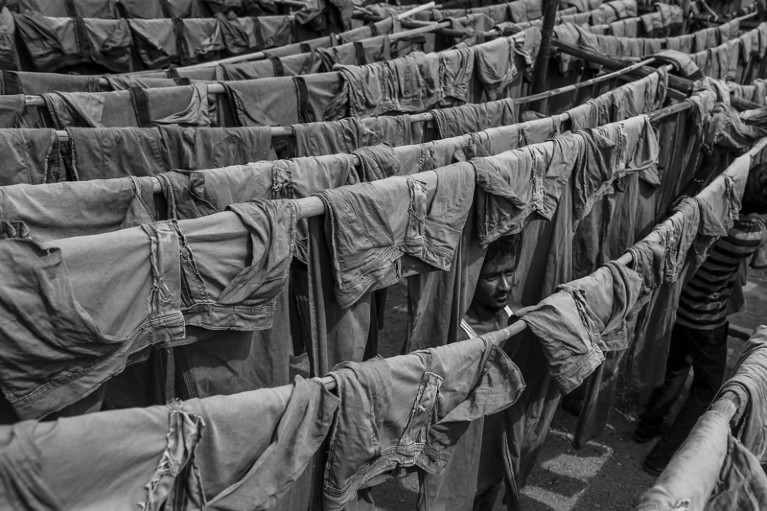
Jeans production uses toxic chemicals, but genetically engineered bacteria could make it greener.Credit: Dhiraj Singh/Bloomberg/Getty
In his Latin description of the Gallic Wars, Julius Caesar wrote: “se Britanni vitro inficiunt” — widely translated as meaning that the Britons dyed themselves with woad. Hence, many sources will tell you, the Romans named the ancient people of northern Britain the Picts, or ‘painted ones’. Among the objections to this claim is that woad is not a very good dye for people — it’s caustic and irritates the skin and eyes.
It’s not a great dye for textiles, either. The indigo colour squeezed from plants including woad (Isatis tinctoria) doesn’t dissolve in water and so can’t penetrate and bind cloth fibres. Instead, it must be chemically converted into a water-soluble compound called leucoindigo, or white indigo, which then adsorbs to the textile surface. It is most commonly used on denim. Over 4 billion denim garments are produced each year. These days, most are dyed blue with synthetic indigo, but the artificial colour must still be fixed using a potent bleaching agent. This is one reason why indigo dyeing is so polluting, as shown vividly by the numerous rivers in China and elsewhere that have been turned blue by untreated waste from jeans factories. According to environmental groups, textile dyeing is one of the most polluting industries in the world.
Indigo dyeing is so widespread that it is hard to replace with a cleaner process. But scientists are trying. Writing online in Nature Chemical Biology, researchers describe a more environmentally friendly method of making and applying indigo dye that relies on genetically engineered bacteria (T. M. Hsu et al. Nature Chem. Biol. http://dx.doi.org/10.1038/nchembio.2552; 2018).
The process borrows a chemical switch from nature. Inside plant leaves, the unstable indigo precursor indoxyl is combined with glucose and stored as a colourless molecule called indican. The researchers mimicked this by adding genes to Escherichia coli bacteria to make them secrete indican. To dye material with this biosynthetic indican, the scientists dissolved it in water and applied the solution alongside an enzyme that stripped away the glucose to re-form indoxyl. This indoxyl then spontaneously oxidized to leucoindigo. When removed from the liquid, the leucoindigo reacted with the air and turned to indigo.
The clever mechanism goes further than previous attempts to clean the process, because it kills two polluting birds with one stone. First, it does away with the wasteful chemical synthesis of indigo.
Second, unlike previous indigo biosyntheses, this project removes the damaging bleaching stage that converts indigo to leucoindigo.
Industry churns out some 50,000 tonnes of synthetic indigo a year, and the bacterial system will need to be optimized and scaled up to make it commercially viable. The glucose molecules must be separated and removed, for one, and the enzyme used to liberate the indoxyl is expensive.
The scientists are optimistic that these challenges can be overcome. Are they right to be? One reason that biofuel production is cheap enough to be possible commercially is that it uses enzymes farmed from fungi. A useful step to prove the credentials of the greener denim dye would be to develop a similar low-cost way to make the required enzyme. Still, indigo production has not always welcomed novelty. Until well into the eighteenth century, France protected its woad industry by threatening users of indigo imported from India and other foreign sources with the death penalty. But given that the popularity of blue denim shows no signs of slowing, the process that produces it sorely needs a new trend.

 Define biomass sustainability
Define biomass sustainability


